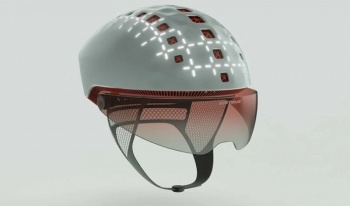
Recently, additive manufacturing has introduced us to many projects that have centered on improving bicycles including bicycle saddles, frames or even stems. Now the 3D printed bicycle helmet also joins the list of these projects. The special thing about this bicycle helmet, named PYLO, is on the one hand of course the fact that it was 3D-printed, but also thanks to its smart features. The manufacturer, nFrontier, which is based in the German capital Berlin, hopes that the helmet will be the first step towards their goal of a “better tomorrow enabled by impact driven products, business models and ventures”.
Although the PYLO bicycle helmet is the first product that nFrontier has introduced to the market since its founding in 2020, it integrates a number of different technologies. For example, we can see design, additive manufacturing and digital high-tech combining together to make one innovative product. This is because it was particularly important for the company that a bicycle helmet should meet the needs of athletes and recreational riders. In concrete terms, this meant that the helmet should be made of lightweight material that does not put too much strain on the head, combined with a modern and elegant design.

Photo Credits: nFrontier
Improving a Bicycle Helmet With 3D Printing
After spending the years since its inception mainly searching for suitable technology partners to realize its PYLO bike helmet, the company turned to 3D printing and design. Notably, nFrontier used Autodesk 3DSMax for the software part, and as for the final printing, they used the F370 and J55 3D printers – both from 3D printing manufacturer Stratasys. What has been 3D printed specifically is the inner lining of the helmet. This not only reinforces the bike helmet itself in terms of its mobility, but it also has the effect of being comfortable for the helmet wearer.
However, this bike helmet stands out not only with its use of additive manufacturing, but also its other exciting features. For example, PYLO also contains an airbag that protects the jawbones, teeth and eyes in the event of an accident. This opens on its own. In addition, it has LED lights that have been placed on the back of the helmet. Head and tail lights, as well as blinders made of LED can be turned on by double tapping while driving. Another highlight of PYLO is at the same time most important for the cyclist: the LIDAR technology (Light Detection and Ranging) is a safety system that allows the cyclist to see when dangers gather in the blind spot or even when vehicles of all kinds approach the cyclist at too high a speed.

The PYLO bicycle helmet contains a self-releasing airbag (photo credits: nFrontier)
Daniel Büning, CEO of nFrontier explained further, “To enhance bike rider safety, we see the urgent need for a technology transfer from the automotive, electronic, and computer industrie. Reducing the number of accidents is a key driver to bicycle utilization as a means for sustainable mobility.” To learn more, click HERE.
*Cover Photo Credits: nFrontier



